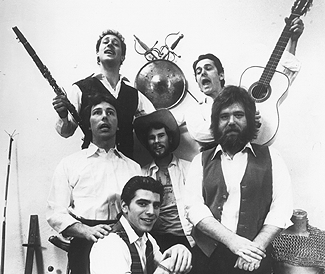

Top: Robin Wood, Dikki Ellis
Middle: Kent Shelton, Omms, Vince Park
Bottom: Taso Stavrakis
Magic, Music and Mayhem
by M.S. Harris
(Reproduced with permission from Renaissance Magazine)


Since springing up from humble beginnings in California during the mid 1960s, Renaissance faires have grown during the last three decades into a national pastime, spawning countless cottage industries and blossoming into a multi-million dollar entertainment industry. With dozens of modern Renaissance festivals across the country and more starting up every year, the seasonal faire circuit employs a huge variety of entertainment acts which might never have existed without the unique performance opportunities provided by the faires.
During the unpredictable and often hectic years since the first Renaissance Pleasure Faire in California in the early 1970s, several such independent acts have continued to exist, thrive, evolve, and amaze faire patrons. Of these acts, the Hanlon-Lees Action Theater remains one of the most popular and durable equestrian combat troupes in outdoor entertainment.
The Birth of a Company
Founded in 1980 by Kent Shelton and Robin Wood, the Hanlon-Lees Action Theater was originally intended to be a stylized, albeit somewhat Americanized, version of Commedia, performed from the back of a travelling wagon. Simple one-act farces were developed, comprised mostly of songs and jokes punctuated by juggling and tumbling, with an occasional magic trick thrown in for good measure. This was the beginning of the (New) Hanlon-Lees Action Theater (H-LAT), and during the early 1980s, the original H-LAT wagon shows delighted and thrilled audiences at the New York Renaissance Festival in Tuxedo, NY, as well as the original New England Renaissance Festival.
In 1979 at the New York Faire, the founders of H-LAT were asked by the management about mounting a live-action joust. Shelton and Wood were intrigued; both men had been trained in stage combat while attending the North Carolina School of the Arts, and Shelton was an avid rider since childhood. Combining Shelton's equestrian skills with both men's physical and theatrical abilities, they set out to create a theatrical joust show while continuing their other duties at the faire. It was no easy task, and a difficult period of invention and development followed. In 1979, there were no theatrical jousting shows in the United States. Up until then, almost all Renaissance Faire jousting had been confined to equestrian dressage displays: the lancing of rings and/or mock-combat by local SCA groups. Suitable equipment such as lances and shields had to be developed and tested for theatricality, durability, and, above all, practicality.
At first, jousting horses were rented. Through a laborious process of trial-and-error, the two men devised a system by which to train the animals for "medieval" combat. Few actual texts on the subject had survived the centuries, and those that had were either vague or unavailable. Undaunted, they pressed on. Over an amazingly short period of time, they were able to determine what sort of equipment and techniques were required for the show, although acquisition of the necessary equipment took longer and required more ingenuity.
An entertaining and engaging show format also needed to be devised, one which would showcase the skills of the character knights without sacrificing the excitement and urgency needed to carry a scripted plotline throughout the day. It was eventually decided that the show would consist of three interdependent acts performed at different times throughout the faire day, each self-contained but a continuation of the previous one. The formula was: "Equestrian Games" in the first act, "Combat" in the second act, and a staged "Joust-to-the-Death" as the finale. Although variations of this formula have been tried during the intervening years, this basic show structure continues to be used by H-LAT (and several other joust companies) to this day.
As the outdoor equivalent of a theater stage show, all of the combat performed by H-LAT was then, and still is, professionally choreographed. Standard theatrical conventions such as artificial blood, trick weapons, and pre-set special effects were included, depending upon the needs of the script. The jousting, however, is by necessity real; there is simply no way to simulate lance-to-shield contact without actually doing it, nor is there any way to fall from a running horse without risk. A planned or choreographed fall from a horse is still a fall from a horse, and despite thorough preparation, it is at best an unpredictable business.
During the early years, H-LAT jousters wore only theatrical armor, never intended to withstand the impact of a fall from a cantering horse. Scrapes, bruises, and muscular injuries were commonplace; not surprising when one considers the inadequacy of most Ren Faire tilt arenas. Theatrical jousting was a new innovation at modern Renaissance events, and proper facilities for such activities were yet to be installed.
Undaunted, Shelton and Wood continued to reinvent their craft as they went along. The first jousts were crude, hardly impressive by modern company standards, but still amazingly popular. After a fairly successful first year, it was time to expand. They enlisted the aid of other actors/stuntmen with the desire to participate in something new and more than a little dangerous.
Each of these new additions brought something unique into both the Wagon Shows as well as the jousting arena; among them were Dikki Ellis, Vince Park and Taso N. Stavrakis. Ellis, an old friend of Shelton's, was an able juggler and acrobat as well as a student/protege of the famed Swiss clown Dmitri; Park was an actor/director who set the tone of the early shows as the Medieval Master of the Lists, serving as director and "ringmaster;" Stavrakis was an actor/stuntman who had recently appeared in the film Knightriders and who now eagerly traded in his motorcycle for a horse.
Another talent who performed with the Hanlon-Lees in those early days was Omms, a director/designer and trained stage combatant. All four men took an active part in the joust shows, as well as appearing in the wagon shows during the first three years of the troupe's existence. With the addition of Ellis, Park, and Stavrakis in 1980 and Omms in 1981, the Hanlon-Lees at last became a formalized performance company.
The co-existence of their two show formats (wagon & joust) necessitated a hectic performance schedule, often consisting of up to eight shows a day. Yet they haven't lacked for willing actors. One early Hanlon-Lees Wagon Show performer, singer/actor Terrence V. Mann later rose to fame on the Broadway stage in such shows as Cats and Les Miserables, as well as in numerous screen appearances. When Mann moved on, others were eagerly waiting in the wings to take his place.
At last, H-LAT decided to take their show on the road their reputation had preceded them and other faires wanted the "New York Joust."
Hanlon Who?
The Hanlon-Lees take their name from an actual historical theatrical circus group from the 19th century. Familiar with their history, Vince Park sought out the last surviving descendant of the original group, obtaining her blessing and permission to use the Hanlon-Lees name. When informed about the new Hanlon-Lees and their activities, she was delighted, satisfied that the new group retained much of the spirit and daring of the original. Now convinced that they were indeed on the right track, Park and the others returned to their shows, determined to live up to the reputation of their namesake.
In 1981, H-LAT left the New York Faire, and moved on to the Texas Renaissance Faire, the New England Renaissance Festival (later renamed King Richard's Faire of Carver, MA), and its sister show, KRF of Kenosha, WI. The latter two Renaissance festivals became H-LAT's primary performance venue during the first half of the 1980s.
This proved to be a demanding and difficult time as the fledgling company braved long hours on the road, poor travel conditions, and undependable vehicles trucking their horses and equipment. They often travelled by night, unwilling to be seen in such dire straits.
Although not yet organized along professional company lines, the Hanlon-Lees Action Theater was starting to assume its current shape. The other actors in the group previously relegated to supporting roles in the joust show were being trained to perform the dangerous joust. As more performance dates and more faires were added to the schedule, more personnel were recruited and the company grew. During this period, H-LAT performed original shows both onstage and off, one of which (Le Petite de Jeuner, later retitled Etched in Stone) proved remarkably successful during a limited run off-Broadway.
Over time, however, the stage and wagon shows proved too exhausting to maintain, so they were discontinued after 1984 (although they have been periodically revived and performed at such venues as the Lincoln Center for the Performing Arts in NYC). Meanwhile, the original joust show format was re-written and revised, gradually developing into the joust performed by H-LAT today. New jousters were trained, a few of whom have since left the folds of H-LAT to found their own companies, each taking with them the seminal training which they learned under the Hanlon-Lees banner.
H-LAT continues to add new stunts and tricks to its repertoire, and costumes have long since been standardized. In 1987, the official historical time period of the Hanlon-Lees shows was formally updated from 1200 AD to 1350 AD, ushering in the use of real plate armor to supplement company chainmail. The new time-frame seemed an ideal choice: it was the period of Edward III and his famous son, the Black Prince of Wales; it encompassed the start of the Hundred Years War and the founding of the Knights of the Garter; and it coincided with the inception of the chivalric ideal which has so inundated the modern perception of feudal knighthood. The mid-14th century is regarded by many to encompass the transition from practical chivalry into high chivalric romance, and so that period was chosen as the time-frame wherein each Hanlon-Lees performer would ride forever pursuing the quest to be named "gentil parfait knight."
Today, the Hanlon-Lees Action Theater performs at Renaissance festivals throughout the country, trucking their road crews to new venues nationwide. Hundreds of thousands of faire-goers have thrilled to their exploits, and company members have distinguished themselves in such entertainment media such as radio, television, film, and most recently, on CD-ROM.
Robin Wood retired from jousting in 1985 and is now a lawyer. Dikki Ellis remains closely involved with the management of the company and works with the Big Apple Circus. Vince Park now works in the computer industry. Kent Shelton, Taso Stavrakis, and Omms continue to perform with H-LAT, working to expand and redefine American theatrical jousting as an industry. Although members have come and gone, the founders of the Hanlon-Lees Action Theater stay in touch with most of their past personnel, always willing to split a beer and share a laugh with an old comrade. In the words of Kent Shelton, "Once a Hanlon-Lee, always a Hanlon-Lee."

